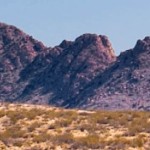Why there’s a federal land dispute brewing out West

WHOSE LAND IS THIS LAND? Unlike states in the East, vast swaths of acreage in the West is owned by the federal government.
By Rob Nikolewski │ New Mexico Watchdog
ALBUQUERQUE, N.M. – Glance at a map showing the percentage of state land owned by the federal government and you’ll see a remarkable difference between the East and the West.
East of the Rocky Mountains, the feds own no more than 13 percent of the land in any state. West of the Rockies, in the continental U.S., the federal government owns at least 29.9 percent of the land in each state. In eight states — California, Oregon, Idaho, Nevada, Utah, Arizona, New Mexico and Wyoming — the feds own more than 40 percent of the land.
When Alaska (69.3 percent) is included, that number grows to nine.
Take a look:
Carl Graham thinks that should change. He’d like to see the federal government transfer some — but not all — of those vast swaths of territory to the states themselves.
“What we’d like to see is shifting that balance back to where we have more state and local governments, who are much more accountable to their people, making those decisions that affect people’s lives,” said Graham, director of the Sutherland Coalition for Self-Government in the West, based in Salt Lake City.
Graham says in a domestic economic situation rife with sequesters and budget deficits, Western states in particular are too dependent on the federal government. The title of his group’s website makes no secret of that: www.EndFedAddiction.org
There was a time when the federal government owned most of the land in the Eastern states. But in the early 19th century, those lands were transferred to the states through grants, sales and homesteading.
But the same thing didn’t happen for states in the West.
“What happened in the late 19th century was, Teddy Roosevelt and others looked out to the West and said, ‘Hey, nobody’s out there yet really using these lands. Let’s start fencing them off and preserving them and keeping people off of them,’ ” Graham told New Mexico Watchdog.
As a result, there’s a marked difference between the amount of federally owned land between one border state and another, such as Montana (29.9 percent) and North Dakota (just 2.7 percent), even though both states entered the Union in the same year — 1889.
“It’s a matter of fairness,” Graham said. “A promise has been broken.”
Advocates like Graham say states can do a better job of managing land and believe Western states are losing millions of dollars in revenue each year. They’re calling for a Transfer of Public Lands Act to shift some federal land now managed by the U.S. Forest Service and the Bureau of Land Management to state and local control.
“We’re not talking about national park land or wilderness areas, national monuments, military installations or tribal lands,” Graham said during a speech in Albuquerque. “We’re talking about multiple-use land,” totaling about 640 million acres in various Western states. “Nobody is talking about drilling for oil in Carlsbad Caverns.”
But the idea has generated opposition, especially among environmental groups.
“It’s laughable,” John Horning, executive director at WildEarth Guardians New Mexico, said when the subject came up last fall. “Public lands are a birthright for all Americans … I think the state is probably in over its head, acquiring federal land and managing it.”
There’s also the legal question about whether Western states can get federal land transferred to them at all.
For example, the Enabling Act of 1910 that eventually saw New Mexico and Arizona admitted into the Union defers all public land issues to the federal government.
The act states “that the people inhabiting said proposed state do agree and declare that they forever disclaim all right and title to the unappropriated and ungranted public lands lying within the boundaries thereof.”
But the movement has generated momentum.
Utah passed a land transfer bill calling on the federal government to give back 20 million acres; a quick analysis by the Idaho’s State Management of Federal Lands estimated a net gain of at least $51 million if 16.4 million acres of federal land was transferred to state control.
Nevada recently became the fifth Western state to establish a task force to look into the potential benefits of transferring federal land. In one of its early findings, a study showed BLM land in Nevada operated at a loss of 91 cents per acre, while the average of state land operated by four states earned more than $28 per acre.
“That’s an enormous difference per acre when you’re talking about, literally, millions and millions of acres,” Graham said.
But critics question the numbers.
The Southern Utah Wilderness Alliance said advocates of public land transfers are “prepared to waste millions of taxpayer dollars in their quixotic quest to send the federal government ‘a message.’ ”
But Graham says what was good enough for Eastern states such as Maryland should be good enough for Western states, such as Montana.
“It’s not a loss,” he said. “There’s going to be money to fight fires, to maintain roads, to take care of recreational facilities. The revenues that can responsibly taken from these lands while still conserving them are more than adequate to manage them.”
Here’s New Mexico Watchdog’s interview with Graham before he spoke Tuesday night at a conference sponsored by the Rio Grande Foundation:
Contact Rob Nikolewski at rnikolewski@watchdog.org and follow him on Twitter @robnikolewski







